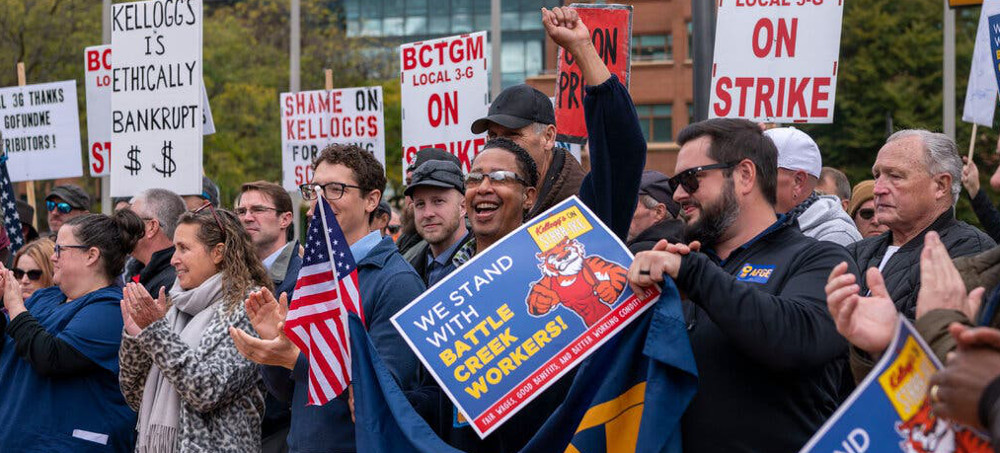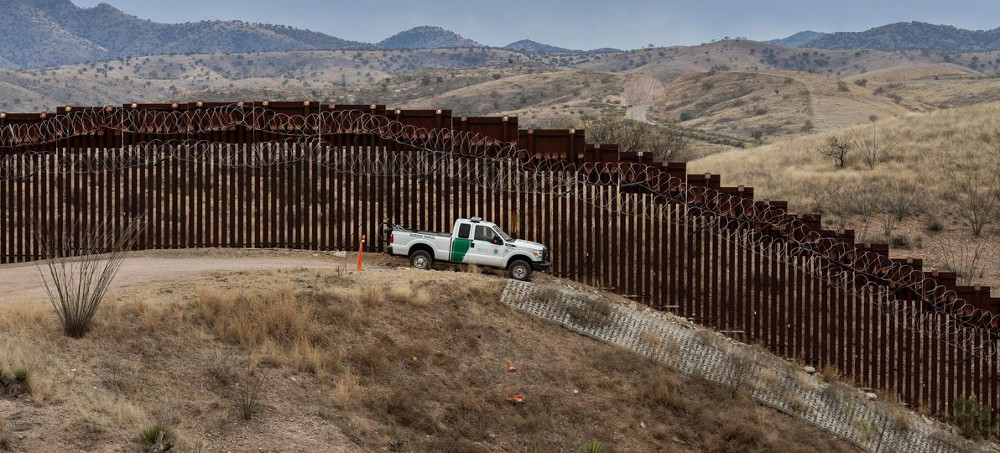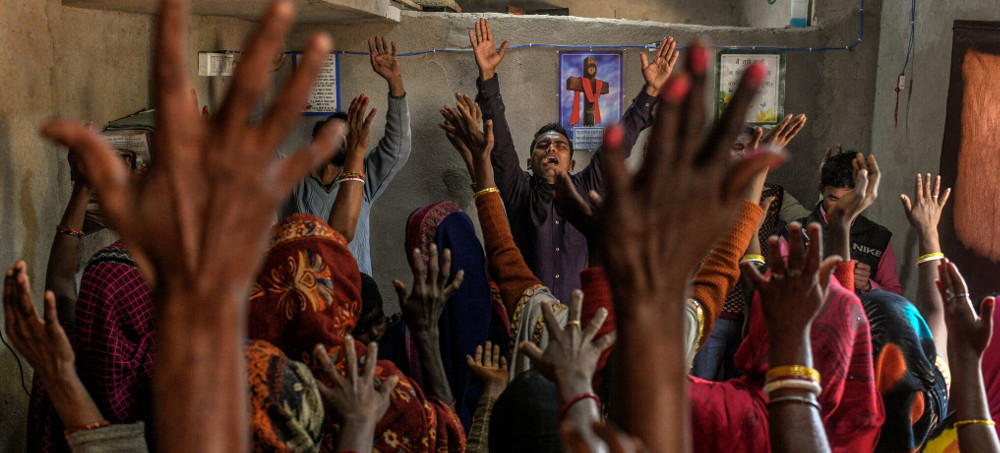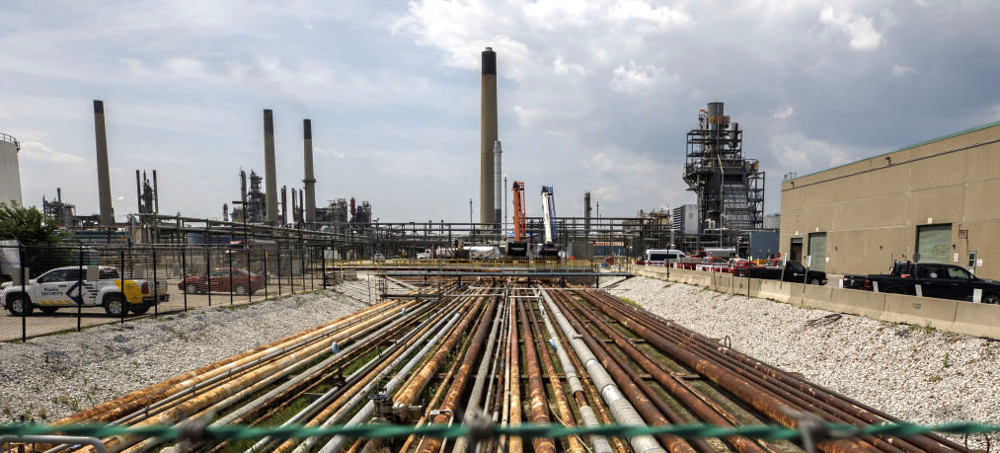We cannot provide service to 100% of our Readership on the donations we receive from 1% of our Readers. A few of you DO help support the project. The vast majority do not. That is not fair to those who are sustaining the project, nor is it fair to the project we all want RSN to be.
We love this project and this community, but we must ask you in the strongest terms to take the funding drives more seriously.
In earnest,
Marc Ash
Founder, Reader Supported News
If you would prefer to send a check:
Reader Supported News
PO Box 2043 / Citrus Heights, CA 95611
Follow us on facebook and twitter!
Live on the homepage now!
Reader Supported News
The pipeline giant Enbridge is making a novel argument in defense of jacking up consumer prices: the climate crisis is heating up, so Enbridge needs to make higher profits now.
Last month, Ohio Republican governor Mike DeWine — who has raked in nearly $400,000 from fossil fuel industry donors — demanded the Biden administration keep open Enbridge’s controversial Line 5 pipeline, which runs under the Great Lakes, as a way to reduce energy prices.
But Enbridge just dropped a bombshell undercutting that argument: the firm told government regulators that climate change means its tar sands pipeline network only has nineteen years left of economic life. That assertion could allow the company to jack up the tolls that its customers pay to transport oil through its pipelines, because pipeline operators are authorized to recoup their operational costs through rate increases — and a shorter timetable means higher levies.
The episode is a spectacle of what’s been called disaster capitalism: In this case, a fossil fuel behemoth is citing the ecological crisis it is intensifying as a justification to extract more profits from consumers already being crushed by higher prices.
“There is something ironic about pipeline companies like Enbridge conceding that they can see the writing on the wall, they’re not going to be competitive or needed less than twenty years from today, and, as a result, they have to raise prices today to account for that,” said Ari Peskoe, director of the Electricity Law Initiative at the Harvard Law School. “There’s something incongruous about that.”
A Changing Environmental and Political Landscape
Enbridge has been doing everything in its power to preserve and expand its massive pipeline network, the largest in North America. The multinational completed construction on its expanded Line 3 pipeline in Minnesota this fall, despite years of heated opposition from Indigenous people, climate activists, and lawmakers. Now the company is working to derail Michigan governor Gretchen Whitmer’s reelection bid, in response to Whitmer’s order aiming to shut down the company’s aging Line 5 pipeline, because a spill could be imminent and the pipeline runs through the Great Lakes.
In that battle, Enbridge has insisted that shutting down Line 5 would cause a spike in fuel prices, because the pipeline supplies ten refineries in the region. And yet, this May, the company told federal energy regulators that its pipelines are likely worth far less because governments are preparing to try to combat the carbon emissions from its products.
The admission was included in filings with the Federal Energy Regulatory Commission (FERC), the US regulatory body which regulates electricity, oil, and natural gas as part of ongoing tariff negotiations with the oil companies that use its pipeline network. During the negotiations, Enbridge filed a depreciation study in May 2021 in which it proposed an accelerated depreciation schedule for its Lakehead System, which transports crude oil from the Alberta tar sands through the Upper Midwest.
In that study, Enbridge estimated that the Lakehead System had an economic life of nineteen more years, a downgrade from its 2016 estimate in which it projected a lifetime of at least thirty years. Enbridge was not required to update those estimates until 2026, but filed the latest depreciation filing five years early as part of the negotiations.
Enbridge cited a number of factors in justifying the shorter expected life of its pipelines, including: “current and anticipated competition to the Enbridge Mainline, actions by state and local governments, and the uncertainty arising from the recent acceleration in the pace of Federal (United States and Canada), state/provincial and local governments passing decarbonization legislation or adopting policies that may influence the market demand for pipelines.”
Enbridge brought up these matters in its tariff negotiations because the rates for using pipelines are set by FERC to account for pipeline companies’ operational costs — infrastructure investments, salaries, maintenance, and other expenses — as well as reasonable profit. As a result, if the economic life of a pipeline ends up being shorter, the company won’t be able to collect payments from customers for as many years, so it can raise rates in order to recover its construction costs.
“These filings take into consideration the changing environmental and political landscape in which we operate this critical piece of energy infrastructure,” Enbridge spokesperson Juli Kellner told Jacobin.
The tar sands companies that move their oil through Enbridge’s pipelines filed a protest with FERC disputing the 2040 truncation date because they don’t want to pay a higher rate. The protest, filed by the Canadian Association of Petroleum Producers (CAPP), asks FERC to “investigate the factual basis of the claims that Enbridge makes regarding its remaining economic life.” According to the protest, “The claim that the Lakehead System may be, indeed will be, out of business in [2040] is remarkable given the entirety of the factual circumstances.”
Kellner said that the depreciation study “is used to determine the cost-of-service toll,” but noted: “It may not reflect the actual life of the assets.”
It’s possible that Enbridge and its customers will come to a settlement through ongoing negotiations before FERC has to intervene.
Whether or not the pipeline company and the oil firms come to an agreement, the negotiations point to a problem that experts say will become increasingly common in coming years: As the big business of extracting and moving crude oil comes to an end, who should bear the cost and risk of that transition?
Passing the Buck
One of the central issues considered during the Minnesota Public Utility Commission’s multiyear permitting process for the Line 3 pipeline through the state was whether there was sufficient demand for oil to justify building the new pipeline. Enbridge said in its April 2015 application for a “certificate of need” for the pipeline: “The anticipated economic life of the Project will be no less than 30 years.”
Enbridge repeated that estimate over the course of the permitting process, said Paul Blackburn, an attorney for Honor the Earth, an environmental justice organization which has opposed Line 3. “Thus, the [new depreciation study] represented a fundamental shift in Enbridge’s understanding of its future,” Blackburn said.
Enbridge has said the latest study does not apply to the Line 3 pipeline because it was under construction when the study was conducted. But Blackburn disputed that a single passage of the pipeline network could outlast the rest.
“Enbridge implies that new Line 3 can keep operating even if the rest of the Mainline System is not, and of course this is a blatantly false statement, because new Line 3 is just one piece of the system: It receives crude oil from other upstream pipelines and tanks owned by Enbridge, and new Line 3 delivers oil to other downstream pipelines and tanks,” he said. “If these other Mainline System pipelines and tanks ceased operation, it would be impossible for new Line 3 to continue operating.”
But experts say Enbridge’s new statement does raise questions about who should bear the cost of the accelerated depreciation.
“The environmental groups and the oil and gas companies agree on accelerated depreciation. The fossil fuel companies recover the money for their infrastructure and the environmental groups get an earlier shutdown,” said James Coleman, professor of energy law at Southern Methodist University. “The challenge for that is, and has always been, the consumer groups. And if you start charging more, and that shows up in oil and gas prices — we’ve seen that might be politically sensitive.”
Some of those costs will be assumed by energy customers in Minnesota, where Enbridge — with the support of local officials and police — forced through completion of its Line 3 pipeline this summer in the face of herculean efforts by Indigenous-led groups to stop it.
“The oil industry attempts to pass all of its costs onto consumers, so it is likely that Enbridge’s tariff rate increases will be passed onto consumers,” said Blackburn of Honor the Earth. “The supporters of new Line 3 who claimed it would reduce fuel costs in Minnesota because it would increase supply completely disregarded the complexity of this market.”
It doesn’t help that no one is sure how much oil will be needed several decades from now — and that’s not just because Enbridge and oil companies are currently arguing over the matter in tariff negotiations. Enbridge’s proposed oil pipeline truncation date, which tar sands companies are lambasting as being too early, is still far later than what scientists say is necessary to stave off catastrophic global warming.
“We live with a certain amount of cognitive dissonance about these inconsistent commitments, and for companies and regulators like FERC, they really have to square that circle and make some kind of prediction about what’s going to happen,” Coleman said. “The rates that they are recovering today depend on what oil use is going to be in 2040 versus 2050. We have this wild asymmetry in predictions about what oil use will be in 2022. So how are we supposed to have accurate predictions about 2040 or 2050?”
Stranded Assets
Regulators and lawmakers will also have to soon tackle a bigger question: Who should bear the costs of soon-to-be stranded assets, such as natural gas and oil pipelines?
If a careful plan isn’t put in place to account for the costs of pipelines that will soon be obsolete, the burden will likely fall on those who are least equipped to handle it, according to a 2019 report by the Environmental Defense Fund in California on the state’s natural gas infrastructure.
“What [would end] up happening is you make [electricity bills] more expensive through accelerated depreciation, which will further motivate customers who can afford to leave the gas system early,” said Michael Colvin, coauthor of the report and director of Regulatory and Legislative Affairs for California at the Environmental Defense Fund. “That will leave behind customers who aren’t able to electrify, so you end up with a tradeoff where wealthier and whiter customers who own their own homes and have more site control electrify, while the remaining customer base, which tends to be low and middle income, and more renters, are left behind.”
That’s why in California, where newly passed climate legislation is likely to lead utilities to shorten the lifespan of their natural gas pipelines, according to the report, advocates and regulators are trying to take a forward-looking approach to the situation, including phasing gas out on a planned timeline.
If governments set targets and require utilities to submit plans to recover their costs, the eventual abandonment of this infrastructure can be managed with an emphasis on equity, Colvin explained. There are tools that policymakers have at their disposal to shield low-income customers from bearing most of the risk, such as covering some of the cost of decommissioning pipelines with tax dollars, or forcing utilities to eat some of the cost through lower profits. Regulators already have the authority to reduce the profits that companies like Enbridge earn from rate collection.
Increased energy bills aren’t the only way the pipelines’ shortened life spans will impact the people who live in the regions that have been torn apart by the construction of Line 3, which contributed to droughts and leaked drilling fluids in waterways during construction last summer.
In Minnesota, Honor the Earth has responded by petitioning state regulators to make sure Enbridge keeps its promise, as part of the permitting process, to set aside money for the eventual decommissioning of the pipeline, which is estimated to cost $1.5 billion or more.
“The Commission should not wait to act on the matter,” Honor the Earth said in the petition. “It should promptly establish a robust and secure funding mechanism as soon as possible to ensure that new Line 3, once abandoned, does not become a financial burden on private as well as state and local government landowners.”
 A memorial in Minneapolis for victims of police violence. (photo: Joshua Rashaad McFadden/The New York Times)
A memorial in Minneapolis for victims of police violence. (photo: Joshua Rashaad McFadden/The New York Times)
George Floyd’s murder set in motion shock waves that touched almost every aspect of American society. But on the core issues of police violence and accountability, very little is different.
Like the conviction of Derek Chauvin for the murder of George Floyd, the verdict on Thursday against Kimberly Potter on two counts of manslaughter for the shooting death of Daunte Wright during a traffic stop represented an unusual decision to send a police officer to prison.
And yet, despite the two high-profile convictions in Minneapolis, a review of the data a year and a half after America’s summer of protest shows that accountability for officers who kill remains elusive and that the sheer numbers of people killed in encounters with police have remained steady at an alarming level.
 Representative Thomas Massie shared a Christmas photo of his family holding guns on Twitter, December 4, 2021. (photo: Twitter)
Representative Thomas Massie shared a Christmas photo of his family holding guns on Twitter, December 4, 2021. (photo: Twitter)
Who is really ‘waging a war’ on Christmas in the US?
On December 4, Representative Thomas Massie of Kentucky tweeted a Christmas greeting with a photo of himself and his grinning family in front of a Christmas tree, armed to the teeth with assault weapons powerful enough to lead a small militia.
The image was posted just four days after 15-year-old Ethan Crumbley allegedly killed four of his fellow students and injured seven others at Oxford High School in Michigan in what was this year’s deadliest school shooting. Just one day before the shooting, Crumbley was caught by teachers searching for “ammo” on his phone. Massie captioned the photo with his wish for Santa to “please bring ammo”.
Despite receiving backlash for the display of callous indifference towards the innocent lives lost, Massie’s post inspired Representative Lauren Boebert of Colorado to share her own gun-filled Christmas family photo, featuring her young children.
This brazen promotion of gun culture among children – just days after a deadly school shooting – is deeply disturbing. It reflects a desensitisation to gun violence in a country where mass shootings, and school shootings, in particular, have become the “new normal”. It also shows that some Republican officials will stop at nothing – even killing the spirit of Christmas – to self-promote.
The statics on gun-related deaths in the US are truly appalling. Firearms have become the leading cause of death for American children and teenagers; those between the ages of five and 14 are 21 times more likely than children in other high-income countries to be killed by gun violence. On average, eight American children die each day from gun violence.
As children spent more time at home in the first year of the pandemic, with greater access to lethal weapons, unintentional gunshot deaths by minors jumped by 31 percent from March to December 2020 compared to the same period in 2019. As schools reopened this year, school shootings returned with, 24 such incidents taking place across the country since August.
The pervasive nature of gun violence in the US has increased policing of schools and spread anxiety among students. American children are now attending schools equipped with metal detectors and security cameras and are being subjected to regular shooter drills.
Exposure to gun violence can impact a child’s emotional, psychological, and even physical development, making it paramount that children are shielded from gun culture. Republicans, however, do not seem to share this concern. In fact, they appear to believe that intellectual topics like critical race theory are a much more dangerous influence on school children than gun culture.
Massie and Boebert are by far not the pioneers of gun promotion among children during Christmas. In 2015, for example, Michelle Fiore, a Las Vegas Republican assemblywoman, caused controversy by posting a similar Christmas greeting card with her armed family.
Unsurprisingly, it is also not just Republican officials who have turned to social media to brandish their love for weapons. The alleged Michigan shooter had also posted images online showing off his gun arsenal before the attack. His mother, who is charged alongside her husband with involuntary manslaughter as accessories to the shooting, captioned a post of her own, “Mom & son day testing out his new Xmas present.”
These posts get around recent social media restrictions on gun promotion, as platforms have only banned weapons sellers from advertising directly on their sites (in the absence of government regulation).
The viral images of Republican officials brandishing assault rifles across the internet not only serve political and commercial purposes, but also constitute a form of extreme trolling of liberals. They are meant to antagonise liberal-minded Americans and boost the popularity of the authors of these posts among their constituencies.
Ironically, in their pursuit of scoring political points ahead of the holidays, Republicans appear to be doing what they have long accused liberals of: “waging a war” on Christmas. For years, conservatives have claimed that Christmas is “under attack” and its symbols and spirit are being ignored or violated by liberals and their rejection of Christian values.
But as Democratic Representative Alexandria Ocasio-Cortez put it in a re-tweet of Boebert’s photo, “Tell me again where Christ said ‘use the commemoration of my birth to flex violent weapons for personal political gain’?”
Perhaps even more insidious than killing the Christmas spirit with gun culture promoting tweets is the GOP’s relentless effort to block legislation that seeks to increase regulation of gun ownership.
Consistent roadblocks placed by Republicans, the National Rifle Association, and the gun industry have made not only passing any gun control measures difficult but have even stifled research into gun violence. This has forced some Democrats to go as far as adopting GOP-style tactics to pursue regulation of gun ownership.
For example, California Governor Gavin Newsom suggested that lawmakers should pass a gun-control law that allows ordinary citizens to sue those who deal in restricted weapons. The idea is to model the legislation after the anti-abortion law recently passed in Texas, which gives any citizen the right to take to court clinics or individual doctors who violate the state’s abortion ban.
Making meaningful progress on gun control, however, would take more than GOP-style tactics. It is time for President Joe Biden to make good on his campaign promise to tackle the issue and push for decisive action on gun violence. This would necessitate not only tougher gun ownership laws but also combatting the normalisation of gun culture.
The possible prosecution of the Oxford shooter’s parents could be a step in the right direction – towards accountability for the promotion of gun culture among children. Next, the gun lobby and politicians promoting gun culture must also be held to account.
Maybe only then would the vile exploitation of Christmas for political gain by Massie, Boebert, and other Republican officials stop. And maybe only then would we see GOP lawmakers opting to promote messages of love during Christmas. We all could do with some of that right about now.
 Union members and supporters during a rally in October outside Kellogg's headquarters in Battle Creek, Michigan. (photo: Alyssa Keown/AP)
Union members and supporters during a rally in October outside Kellogg's headquarters in Battle Creek, Michigan. (photo: Alyssa Keown/AP)
In a major victory for labor rights, 1,400 unionized Kellogg’s workers have ended their nearly three-month strike across four states after approving a new contract that provides a wage increase and enhanced benefits for all. The prior agreement that Kellogg’s tried to bargain only offered wage increases and improved benefits to longtime workers, whereas the new agreement ensures newer workers have a guaranteed option to receive the same improvements. We speak with Kellogg’s worker Kevin Bradshaw, who will return to work on Monday alongside his co-workers. “We didn’t have any takeaways and no concessions, so I would say that, in essence, that we did win,” says Bradshaw.
In a major victory for labor rights, workers at Kellogg’s cereal plants have ended their nearly three-month strike after approving a new contract that provides across-the-board wage increases and enhanced benefits for all. Some 1,400 Kellogg’s workers in Michigan, Nebraska, Pennsylvania and Tennessee have been on strike since October. Over the weekend, Senator Bernie Sanders joined striking Kellogg’s workers in Michigan.
SEN. BERNIE SANDERS: In the middle of a pandemic, legitimately, you are heroes and heroines, right? You were feeding America. And it is just outrageous to me that the company responds to your sacrifices by saying, you know, “We’re taking your jobs to Mexico. We’re going to have younger workers coming in at lower wages and benefits,” while they give their CEO $12 million a year, I guess.
AMY GOODMAN: One of the most contested issues has been a permanent two-tier system, where workers at Kellogg’s hired after 2015 were paid less than longer-tenured workers. The new five-year agreement with Kellogg’s doesn’t include the two-tier system, gives workers a clear path to full-time employment and provides a significant increase in the pension multiplier.
We’re joined now by Kevin Bradshaw, president of Local 252G of the Bakery and Confectionery Workers International Union of America. He’s in Memphis, Tennessee, a striking Kellogg’s worker who’s worked for the company for 20 years.
Kevin, welcome back to Democracy Now! Can you talk exactly about what you won?
KEVIN BRADSHAW: Yeah. Thank you for having me.
What we we won was fighting against the alternative work schedule, what the company wanted to introduce. And they wanted to introduce a permanent two-tier wage system. So, we were able to get those things taken off the table, along with some different additional things, like an increase to our cost-of-living allowances for everyone and also for our pension plan. We got a significant increase to our pension plan. So, there was a lot of good things. We didn’t have any takeaways and no concessions, so I would say that, in essence, that we did win.
AMY GOODMAN: Have you already returned to the plant to work?
KEVIN BRADSHAW: No, we return Monday, on December 27th.
AMY GOODMAN: Can you talk about who works at these plants around the country? You’re in Memphis. The demography of the racial breakdown of the workers?
KEVIN BRADSHAW: Well, I would say in Memphis is probably our most predominantly Black plant. The other plants are a little bit more diverse, in Omaha and in Lancaster and Battle Creek. But Memphis is a predominantly Black plant, and always has been.
AMY GOODMAN: And talk about what you produce. What does Kellogg’s make?
KEVIN BRADSHAW: Oh, wow. In Memphis, we make Frosted Flakes, Corn Flakes, Apple Jacks, Froot Loops, Rice Krispies, I mean, different flavors of Rice Krispies. We also make the rice that actually they use to make the Rice Krispie Treats. In other plants, we make all the different other specialty brands. We make Special K, Chex — I mean, not — Shredded Wheat, stuff like that. I mean, it’s so much cereal. I mean, everything that Kellogg’s makes, we make. We feed America.
AMY GOODMAN: And can you talk — I mean, this strike was almost three months. How did the workers get by on the picket line?
KEVIN BRADSHAW: Well, a lot of our workers, we had to acquire other jobs to be able to maintain. And it was a very stressful time of adversity and heartbreak and financial hardships, medical needs. I mean, we made it throughout the different accounts we set up with GoFundMe and stuff like that. We made it from different — all of our different unions across the world, our national AFL-CIO, who’s involved and who helped all our different affiliates across the world, our international staff, President Anthony Shelton and his staff. I mean, we were able to network and reach out all across the world to help maintain. And our international provided weekly funds for everyone, so, you know — which were very appreciated. So we maintained just by networking and coming together, unions all over the world.
AMY GOODMAN: And can you talk about the conditions in the plant, especially in this time of the pandemic?
KEVIN BRADSHAW: Our conditions now or conditions when we go back? Those are — we remain to be seen, when we go back. Right now, you know, we know that some of the plants are probably in bad shape with the replacement workers that they have. We know that things have been broken and stolen and just tore up. So, we’ve got to go back in and rebuild our plants to get them back up to running to be able to feed America.
AMY GOODMAN: And finally, on the two-tiered system, explain more fully the significance of what it means to — have you done away with it entirely?
KEVIN BRADSHAW: Well, what the company was actually asking for was a permanent two-tiered system, where when a new person comes in, they will have no chance to be able to top out at maximum pay. So what we were able to come away with was a guaranteed process that would allow them to graduate. Every year, 3% of the total population at that plant would graduate to what we call a regular legacy full-time employee to receive the same benefits and pension and insurance as myself, as I have. So, it’s a win for us, because there’s no — there is a clear path to be able to get top pay, which the company was not willing to give us to begin with.
AMY GOODMAN: Kevin Bradshaw, we want to thank you so much for being with us, president of Local 252G in Memphis, Tennessee, striking Kellogg’s worker who’s worked for the company for 20 years. They’re going back to work on Monday.
 A Border Patrol officer sits inside his car as he guards the U.S.-Mexico border fence in Nogales, Arizona. (photo: Getty)
A Border Patrol officer sits inside his car as he guards the U.S.-Mexico border fence in Nogales, Arizona. (photo: Getty)
Crossing the US-Mexico border is already lethal. A new study says climate change could make it much worse.
Seeking to understand the impact of the extreme environment on migrants making the trek, a team of researchers modeled the physiological stress of walking through a commonly traversed stretch of the desert from Nogales to Three Points, Arizona. The study, which was published in the journal Science, shows that migrant deaths are concentrated in areas where evaporative water loss and dehydration are more likely.
“Crossing the border across these extreme environments is really dangerous for humans to do and in the next 30 years, with rising temperatures, it’s going to become even more extreme and push those levels to even further beyond what humans can actually sustain,” co-author Hallie Walker, a researcher at the University of Idaho, told The Guardian. “It is incredibly dangerous.”
In the 1990s, border-wall construction and heightened enforcement strategies near high-traffic corridors along the border led to greater numbers of undocumented migrants crossing through rugged, often desolate stretches of desert to avoid apprehension. More than 7,800 migrant deaths were reported from 1998 to 2019, “with many more deaths likely unreported,” according to the paper. Unauthorized crossings spiked to unprecedented levels in 2021, a trend that coincided with a record number of migrant deaths reported by U.S. Border Patrol.
Using information from migrant interviews, human physiology studies and fine-scale climate data, the researchers simulated the rate of water loss for a human traveling on foot along various routes to estimate the “water costs” of making the journey during summer months, including for adult males, pregnant and non-pregnant women, and children.
The researchers then combined multiple, publicly available climate-projection models to predict monthly temperature estimates for 2050. Based on a middle-of-the-road warming model, the projected increases in temperature over the next 30 years are likely to increase the average water cost during migration by 30 to 34 percent.
“Taken together, these results indicate that undocumented migration across the southwest border of the United States will become increasingly dangerous over the next 30 years, which will likely result in increased mortality of migrants,” the authors write.
As political, economic and climatic conditions — paired with an enforcement strategy that funnels migrants into extreme environments — force a growing number of migrants to attempt unauthorized crossings through the Sonoran Desert, assessing the “intersecting impacts of social policy and climate change on human stress and physiology will be of increasing importance as the climate warms,” the researchers say.
 Villagers praying in secret in Bihar, India, amid an uptick in violence against Christians in the country. (photo: Atul Loke/The New York Times)
Villagers praying in secret in Bihar, India, amid an uptick in violence against Christians in the country. (photo: Atul Loke/The New York Times)
“They want to remove us from society,” a Christian farmer said of Hindu extremists. Rising attacks on Christians are part of a broader shift in India, in which minorities feel less safe.
A swarm of men dressed in saffron poured inside. They jumped onstage and shouted Hindu supremacist slogans. They punched pastors in the head. They threw women to the ground, sending terrified children scuttling under their chairs.
“They kept beating us, pulling out hair,” said Manish David, one of the pastors who was assaulted. “They yelled: ‘What are you doing here? What songs are you singing? What are you trying to do?’”
 Coquerel's sifakas (Propithecus coquereli) are critically endangered and are found in only two protected areas in Madagascar, one of which is Ankarafantsika National Park. (photo: Rhett Butler/Mongabay)
Coquerel's sifakas (Propithecus coquereli) are critically endangered and are found in only two protected areas in Madagascar, one of which is Ankarafantsika National Park. (photo: Rhett Butler/Mongabay)
Now a dry forest in Madagascar’s northwest is also threatened. Ankarafantsika National Park, the beating heart of one of the country’s largest dry forests, is home to iconic lemur species such as the critically endangered Coquerel’s sifaka (Propithecus coquereli), as well as about a dozen communities that rely on its resources. For many decades, the park was relatively well protected, but since 2016 it’s faced a serious threat: too much fire.
This year’s fires were the worst yet. Two conflagrations in September and October — peak fire season — together burned more than 40 square kilometers (about 15 square miles), an area that would cover two-thirds of Manhattan. Hundreds of local people used water bags to fight the fires, putting them out after many days in each case. But the damage was severe.
“I am actually shocked after seeing the recent satellite images,” Dominik Schüßler, a research associate and doctoral student in conservation biology at the University of Hildesheim in Germany who’s currently conducting field work in Madagascar, told Mongabay, calling this season’s forest clearance “unprecedented” for Ankarafantsika.
While fires are a natural part of dry forest ecosystems, the scale of these fires damages habitats and threatens the well-being of wildlife and people in the area, scientists say.
“Fire belongs there, but it’s a hard thing to manage — like trying to stop the wind,” Travis Steffens, an evolutionary anthropologist at the University of Guelph in Canada and executive director of Planet Madagascar, a conservation group that works in the park, told Mongabay. “We’re basically seeing a conservation crisis butt up against a humanitarian crisis,” he said.
Burning up, drying out
If dry forests were neglected, Ankarafantsika was an exception: it was among the first protected areas that the colonial government established in the 1920s, and it’s been a relative success story.
Though deforestation has been rampant in Madagascar for the past seven decades or more, Ankarafantsika did not suffer as much as other areas.
From 1996 until 2006, the park lost less than 0.1% of forest cover per year on average, according to a three-volume compendium of Madagascar’s protected areas published by the University of Chicago Press in 2018. Likewise, Schüßler’s research indicates that Ankarafantsika’s forest cover has been relatively stable since at least 1990, with about two-thirds to three-quarters of the park covered.
However, things began to change a bit after a 2009 coup d’état in Madagascar, sending the park’s deforestation rate above 1% — a more than tenfold increase — and the trend has accelerated since then. The park had a major fire season in 2016, and in 2019 the situation got so bad that park managers called for international assistance.
Yet now the park is seeing even more damage. In the last 15 months, it’s lost about 90 square kilometers (about 35 square miles) of forest, according to Schüßler, who’s preparing an article that uses this data. That amounts to 6.6% of the park’s surface area. The “vast majority” of that loss came in 2021, he said.
This year’s two major fires were a big part of that equation, and there were many dozens of smaller forest fires, as well. Fire is the main threat to Ankarafantsika’s people and ecosystems, several experts said.
“Fire doesn’t necessarily cause deforestation,” Steffens said. “[The forest] can recover. But fire does alter forest structure. It can change the landscape if it’s frequent.”
Most local people are rice or cassava farmers, and the fires reduce their yield. They dry out the area, decreasing water availability.
“To grow anything, they need water,” Mamy Razafitsalama, In-Country Director of Planet Madagascar, told Mongabay. “The absence of the forest reduces water production and affects their agriculture.”
Fires also degrade the soil, causing erosion and covering fields in sand, said Ando Rakotomamonjy, a doctoral student in natural ecosystems at the University of Mahajanga and a conservation project manager in the park. This is part of a vicious cycle in which reduced yields lead to further exploitation. “If they can’t cultivate the rice, they find another way to survive, by [for example] producing charcoal,” she said. Charcoal is made by burning wood in a low-oxygen environment to remove moisture, and often comes at the expense of nearby forests.
The fires also put wildlife at risk. There are eight lemur species, most of which are found only in the park and surrounding areas. In addition to the Coquerel’s sifaka, of which there are an estimated 47,000 individuals in the park, these include threatened species such as the mongoose lemur (Eulemur mongoz), the Milne-Edwards’ sportive lemur (Lepilemur edwardsi), and the golden-brown mouse lemur (Microcebus ravelobensis), which is the smallest species of lemur, weighing only two to three times as much as a mouse. The park is also home to more than 140 bird species, including the critically endangered Madagascar fish eagle (Haliaeetus vociferoides), which can often be seen at Lake Ravelobe.
While the most pressing concern for wildlife is habitat loss and fragmentation, the fires also pose immediate threats. After the October fire, Rakotomamonjy found the burned remains of a lemur and a snake.
What’s causing the fires?
This year’s biggest fire started on September 5 and lasted more than a week, burning through about 32 square kilometers (about 12 square miles). It began outside of the park, to the south, near a village called Betsidipahy, and local authorities believe it was primarily caused by a charcoal kiln that got out of control. Two people were arrested in connection with the fire, according to representatives of Madagascar National Parks (MNP), a semi-public agency that manages the park.
Another fire started not far from the park offices on October 15, burning through 9.5 square kilometers (4 square miles). It was a “voluntary act” and an investigation is ongoing, MNP representatives told Mongabay.
The “act” was a form of protest against local forest agents whom a group of area residents disagreed with or perceived to be corrupt, according to Rakotomamonjy, who conducted interviews after the fire.
It’s unclear if this was just a single instance of protest-by-fire or part of a larger trend. Though protest is often casually cited as a reason for rural fires, research suggests it may not be all that common, at least not against national actors or as a result of national politics.
“The observed logic and patterns of resource use strongly point to the conclusion that fires are a straightforward livelihood practice…and not overt protest,” Christian Kull, a geographer and author of Isle of Fire: The Political Economy of Landscape Burning in Madagascar, wrote in a 2002 paper. (Kull is now at the University of Lausanne in Switzerland.)
One common livelihood practice is slash-and-burn agriculture, in which people clear cut the forest and set it on fire to create farmland or pastures for cattle to graze. Conservationists who work in Ankarafantsika don’t have data on how much of the deforestation in the park is due to this practice. (Some conservationists and academics are careful when discussing slash-and-burn agriculture so as to avoid blaming or denigrating subsistence farmers and obscuring the overarching structural causes of deforestation.)
Longstanding residents say migration is contributing to the uptick of fires and deforestation in the Ankarafantsika area. Some of the migration comes from Madagascar’s deep south, which has been stricken with drought in recent years. Rakotomamonjy said newly arrived people are often in dire economic circumstances and need to extract value from the land quickly, and they tend to have less concern for local conservation norms or rules. They often exploit the forest without authorization, she added.
Fighting for the future
Conservationists and local people are fighting the fires on several fronts. In the off-season, they set up and maintain fire breaks. In-season, they monitor the forest from watchtowers and send out regular patrols; when fires occur, they shift into fire-fighting mode.
The government and NGOs have also engaged in education about fires and deforestation. “Some people don’t know the importance of the forest, about animals and their relationship with humans — how wildlife impacts human life,” Razafitsalama, of Planet Madagascar, said, in explaining why education was important.
However, law enforcement authorities have at times grown impatience with the educational approach. “We are raising awareness among the people, but that does not seem very effective,” Ihando Andrianjafy, regional director at Madagascar’s Ministry of the Environment, told Radio France Internationale in 2019. “What we are trying to do now is to discourage them by explaining that these fires are punishable by imprisonment.”
The government has a “zero tolerance” police for forest management infractions, such as unauthorized fires. Punitive approaches to conservation do have critics, however. Kull, the geographer, told Mongabay that he couldn’t speak to current practices, but in the past, Madagascar’s fire enforcement was often arbitrary and focused on small-scale actors. He cited the need for clear rules and consistent, fair enforcement, especially around slash-and-burn.
There are no easy answers for conservationists working in Ankarafantsika, but they are pushing for better fire management practices. “This year was the worst [worst year] since we started working in Ankarafantsika in 2015,” Razafitsalama said, referring to the fires. He said there was an urgent need for action to help local people. “If it hasn’t impacted them directly yet, later, it will.”
This article was originally published on Mongabay.
Follow us on facebook and twitter!
PO Box 2043 / Citrus Heights, CA 95611





 onald Rumsfeld just died at the age of eighty-eight. Obituaries at outlets like the
onald Rumsfeld just died at the age of eighty-eight. Obituaries at outlets like the 
 hile some people charged in the Jan. 6 attack on the US Capitol have
hile some people charged in the Jan. 6 attack on the US Capitol have 
 he chairman of a House subcommittee is demanding that executives of Exxon Mobil Corp., Shell, Chevron and other major oil and gas companies testify before Congress about the industry’s decades-long effort to wage disinformation campaigns around climate change.
he chairman of a House subcommittee is demanding that executives of Exxon Mobil Corp., Shell, Chevron and other major oil and gas companies testify before Congress about the industry’s decades-long effort to wage disinformation campaigns around climate change.
 ast Tuesday, as news coverage focused on New York City’s mayoral race, an upset occurred in New York’s second-largest city.
ast Tuesday, as news coverage focused on New York City’s mayoral race, an upset occurred in New York’s second-largest city. 


 gas leak from an underwater pipeline in the Gulf of Mexico led to a
gas leak from an underwater pipeline in the Gulf of Mexico led to a 